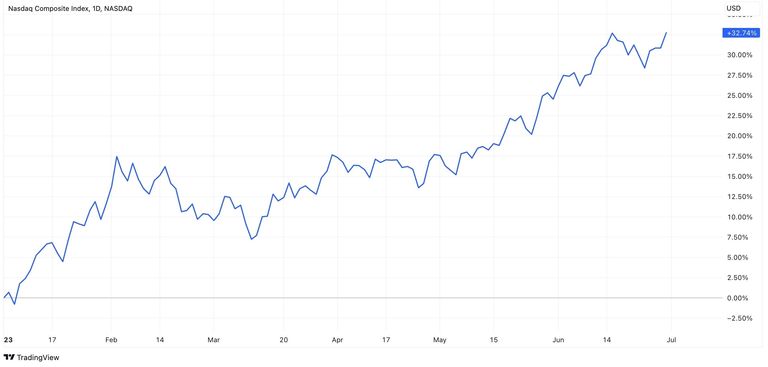Apple stock is at high levels, and Nvidia stock beats records. Assets related to US stock indices appear to be among the best choices one could make at the beginning of 2023. However, how can this be, considering the numerous forecasts of a significant drop in the US market and economy? Let's delve into the reasons behind the rise in US indices and explore the factors that could influence future market movements.
One of the primary global indices, the Nasdaq Composite Index, has risen by 32% since the beginning of the year. You can observe this in the chart below.

By the way, it’s not only stocks that have indices. It’s also vital to monitor currency indices. The most crucial one is the US dollar index (referred to as DXY), which indicates how the USD performs against a basket of other major currencies and helps estimate the true strength of the dollar.
Now let’s get back to US stock indices. A 32% growth over six months is remarkable in itself, but we need a basis for comparison. That’s why we added one broader and one narrower indicator to the previous chart – the S&P 500 index and the index reflecting the performance of FAANG companies.

The FAANG, which includes companies like Meta (META:NASDAQ), Apple (AAPL:NASDAQ), Amazon (AMZN:NASDAQ), Netflix (NTLX:NASDAQ), and Alphabet (GOOG:NASDAQ), has achieved almost 60% growth. Meanwhile, with the inclusion of 500 companies, the S&P 500 has shown good, though not particularly impressive, results. This is significant because big-tech companies are the primary drivers of the increase in the indices. The average result for other stocks is close to zero. In other words, this story mainly revolves around tech companies rather than the overall healthy growth of the US market.
There are several factors behind the success of big tech companies. The first among them is AI technologies. All the big fish are engaged in this AI race, allowing them to score points in investors’ eyes. Secondly, the US economy turned out to be more robust than it seemed. The recession has yet to materialize, and unemployment rates are actually fine. This doesn’t mean the recession won’t occur in the United States in the next 3 to 6 months, but it could indicate a decreased probability.
The general situation remains hard to predict. On the one hand, it’s better than expected. But on the other, the might and influence of big techs are as significant as they were prior to the dotcom bubble.
Joining the big-tech party and earning some extra profit is alluring. However, it also carries risks Plus, the following significant growth of stocks may potentially be affected by the Fed’s policy. For a successful outcome, a delicate balance between interest rate hikes and cuts is necessary. Hikes can make other assets more appealing, while sharp drops can trigger new intensive talks about the risk of recession.
So, what is the recommended course of action? The simple answer is diversification. Stocks are not the sole option for investors. We currently live in times when assets with fixed income offer yields that one should probably not overlook.
A gentle reminder is necessary here – conducting your own analysis before buying or selling any instruments is the key to success.

